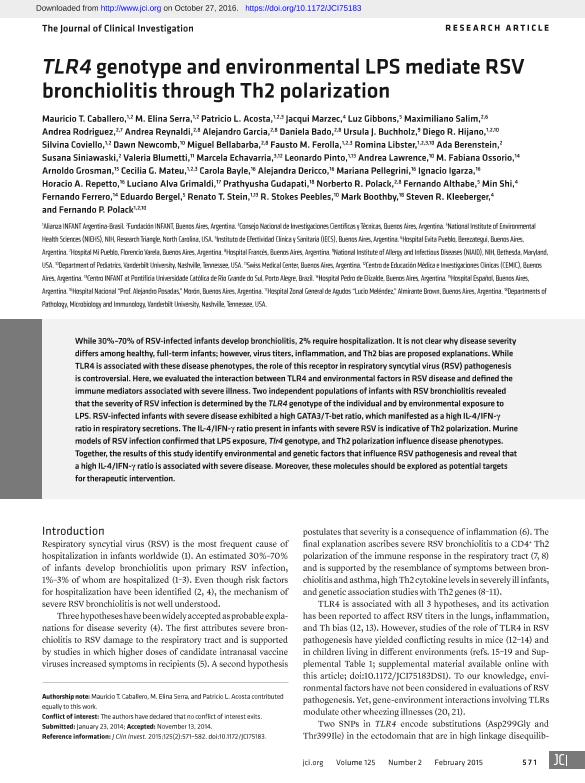Artículo
TLR4 genotype and environmental LPS mediate RSV bronchiolitis through Th2 polarization
Caballero, Mauricio Tomás; Serra, M. Elina; Acosta, Patricio Leandro ; Marzec, Jacqui; Gibbons, Luz; Salim, Maximiliano; Rodriguez, Andrea; Reynaldi, Andrea; Garcia, Alejandro; Bado, Daniela; Buchholz, Ursula J.; Hijano, Diego Raúl; Coviello, Silvina Andrea
; Marzec, Jacqui; Gibbons, Luz; Salim, Maximiliano; Rodriguez, Andrea; Reynaldi, Andrea; Garcia, Alejandro; Bado, Daniela; Buchholz, Ursula J.; Hijano, Diego Raúl; Coviello, Silvina Andrea ; Newcomb, Dawn; Bellabarba, Miguel; Ferolla, Fausto Martín
; Newcomb, Dawn; Bellabarba, Miguel; Ferolla, Fausto Martín ; Libster, Romina Paula
; Libster, Romina Paula ; Berenstein, Ada; Siniawaski, Susana; Blumetti, Valeria; Echavarría, Marcela Silvia
; Berenstein, Ada; Siniawaski, Susana; Blumetti, Valeria; Echavarría, Marcela Silvia ; Pinto, Leonardo; Lawrence, Andrea; Ossorio, Maria Fabiana; Grosman, Arnoldo; Mateu, Cecilia Gabriela
; Pinto, Leonardo; Lawrence, Andrea; Ossorio, Maria Fabiana; Grosman, Arnoldo; Mateu, Cecilia Gabriela ; Bayle, Carola; Dericco, Alejandra; Pellegrini, Mariana; Igarza, Ignacio; Repetto, Horacio A.; Grimaldi, Luciano Alva; Gudapati, Prathyusha; Polack, Norberto R.; Althabe, Fernando
; Bayle, Carola; Dericco, Alejandra; Pellegrini, Mariana; Igarza, Ignacio; Repetto, Horacio A.; Grimaldi, Luciano Alva; Gudapati, Prathyusha; Polack, Norberto R.; Althabe, Fernando ; Shi, Min; Ferrero, Fernando Claudio; Bergel, Eduardo; Stein, Renato T.; Peebles, R. Stokes; Boothby, Mark; Kleeberger, Steven R.; Polack, Fernando Pedro
; Shi, Min; Ferrero, Fernando Claudio; Bergel, Eduardo; Stein, Renato T.; Peebles, R. Stokes; Boothby, Mark; Kleeberger, Steven R.; Polack, Fernando Pedro
 ; Marzec, Jacqui; Gibbons, Luz; Salim, Maximiliano; Rodriguez, Andrea; Reynaldi, Andrea; Garcia, Alejandro; Bado, Daniela; Buchholz, Ursula J.; Hijano, Diego Raúl; Coviello, Silvina Andrea
; Marzec, Jacqui; Gibbons, Luz; Salim, Maximiliano; Rodriguez, Andrea; Reynaldi, Andrea; Garcia, Alejandro; Bado, Daniela; Buchholz, Ursula J.; Hijano, Diego Raúl; Coviello, Silvina Andrea ; Newcomb, Dawn; Bellabarba, Miguel; Ferolla, Fausto Martín
; Newcomb, Dawn; Bellabarba, Miguel; Ferolla, Fausto Martín ; Libster, Romina Paula
; Libster, Romina Paula ; Berenstein, Ada; Siniawaski, Susana; Blumetti, Valeria; Echavarría, Marcela Silvia
; Berenstein, Ada; Siniawaski, Susana; Blumetti, Valeria; Echavarría, Marcela Silvia ; Pinto, Leonardo; Lawrence, Andrea; Ossorio, Maria Fabiana; Grosman, Arnoldo; Mateu, Cecilia Gabriela
; Pinto, Leonardo; Lawrence, Andrea; Ossorio, Maria Fabiana; Grosman, Arnoldo; Mateu, Cecilia Gabriela ; Bayle, Carola; Dericco, Alejandra; Pellegrini, Mariana; Igarza, Ignacio; Repetto, Horacio A.; Grimaldi, Luciano Alva; Gudapati, Prathyusha; Polack, Norberto R.; Althabe, Fernando
; Bayle, Carola; Dericco, Alejandra; Pellegrini, Mariana; Igarza, Ignacio; Repetto, Horacio A.; Grimaldi, Luciano Alva; Gudapati, Prathyusha; Polack, Norberto R.; Althabe, Fernando ; Shi, Min; Ferrero, Fernando Claudio; Bergel, Eduardo; Stein, Renato T.; Peebles, R. Stokes; Boothby, Mark; Kleeberger, Steven R.; Polack, Fernando Pedro
; Shi, Min; Ferrero, Fernando Claudio; Bergel, Eduardo; Stein, Renato T.; Peebles, R. Stokes; Boothby, Mark; Kleeberger, Steven R.; Polack, Fernando Pedro
Fecha de publicación:
02/2015
Editorial:
American Society for Clinical Investigation
Revista:
Journal of Clinical Investigation
ISSN:
0021-9738
Idioma:
Inglés
Tipo de recurso:
Artículo publicado
Clasificación temática:
Resumen
While 30%-70% of RSV-infected infants develop bronchiolitis, 2% require hospitalization. It is not clear why disease severity differs among healthy, full-term infants; however, virus titers, inflammation, and Th2 bias are proposed explanations. While TLR4 is associated with these disease phenotypes, the role of this receptor in respiratory syncytial virus (RSV) pathogenesis is controversial. Here, we evaluated the interaction between TLR4 and environmental factors in RSV disease and defined the immune mediators associated with severe illness. Two independent populations of infants with RSV bronchiolitis revealed that the severity of RSV infection is determined by the TLR4 genotype of the individual and by environmental exposure to LPS. RSV-infected infants with severe disease exhibited a high GATA3/T-bet ratio, which manifested as a high IL-4/IFN-γ ratio in respiratory secretions. The IL-4/IFN-γ ratio present in infants with severe RSV is indicative of Th2 polarization. Murine models of RSV infection confirmed that LPS exposure, Tlr4 genotype, and Th2 polarization influence disease phenotypes. Together, the results of this study identify environmental and genetic factors that influence RSV pathogenesis and reveal that a high IL-4/IFN-γ ratio is associated with severe disease. Moreover, these molecules should be explored as potential targets for therapeutic intervention.
Palabras clave:
RESPIRATORY SYNCYTIAL VIRUS
,
INNATE IMMUNE SYSTEM
,
SNP
,
TLR4
Archivos asociados
Licencia
Identificadores
Colecciones
Articulos(SEDE CENTRAL)
Articulos de SEDE CENTRAL
Articulos de SEDE CENTRAL
Citación
Caballero, Mauricio Tomás; Serra, M. Elina; Acosta, Patricio Leandro; Marzec, Jacqui; Gibbons, Luz; et al.; TLR4 genotype and environmental LPS mediate RSV bronchiolitis through Th2 polarization; American Society for Clinical Investigation; Journal of Clinical Investigation; 125; 2; 2-2015; 571-582
Compartir
Altmétricas



